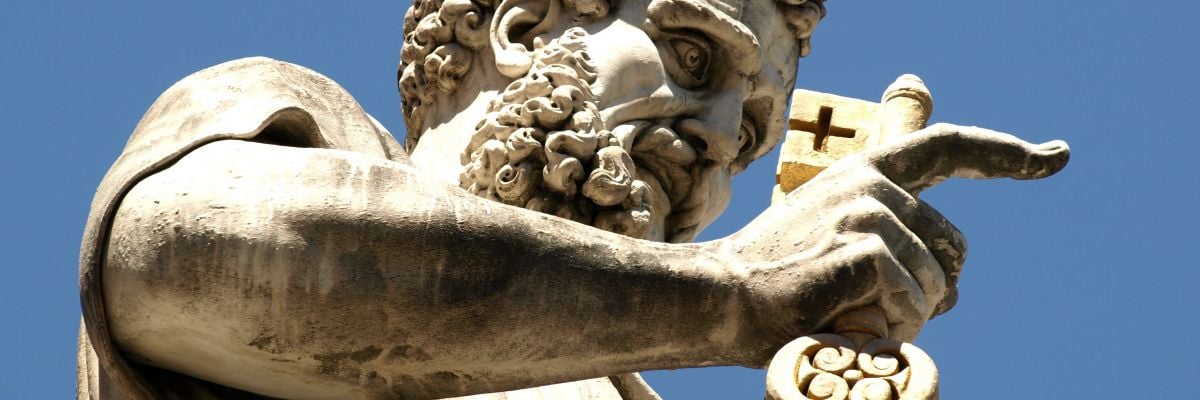
When it comes to Peter, the first pope, few texts have been the occasion for the spilling of more ink than Matthew 16:17-19:
And Jesus answered him, “Blessed are you, Simon Bar-Jona! For flesh and blood has not revealed this to you, but my Father who is in heaven. And I tell you, you are Peter, and upon this rock I will build my church, and the powers of death shall not prevail against it. I will give you the keys of the kingdom of heaven, and whatever you bind on earth shall be bound in heaven, and whatever you loose on earth shall be loosed in heaven.”
For Catholics, this text is clear. All twelve apostles were present, yet Jesus promised to give to Peter alone the keys of the kingdom, symbolizing the authority of Christ—the authority of heaven—over the kingdom of heaven on earth, which is the Church. Yet millions of Protestants believe that there is a distinction in meaning in the Greek text between the two “rocks” that would eliminate Peter from consideration for being the rock.
“Thou art petros and upon this petra I will build my church.” The first rock, petros, is claimed to refer to a small, insignificant rock: Peter. The second, petra, is claimed to mean a massive boulder—that would be either Jesus or Peter’s confession of faith. The argument concludes that Jesus built his church not upon Peter, but upon either himself or Peter’s faith.
Below are seven reasons, among many others we could examine, why Peter is undeniably the rock:
1. The Gospel of Matthew, we have pretty solid evidence, was originally written in Aramaic.
Ss. Papias and Irenaeus tell us as much in the second century. But even more importantly—and more certainly—Jesus would not have spoken his discourse of Matthew 16 in Greek. Greek was the dominant language of the Roman Empire in the first century, but most of the common Jewish folk to whom Jesus spoke would not have been fluent in it. Aramaic was their spoken language.
Moreover, we have biblical evidence—John 1:42—that also points to Jesus using Aramaic in the naming of Peter: “[Andrew] brought [Peter] to Jesus. Jesus looked at him and said, ‘So you are Simon the son of John? You shall be called Cephas’” (which means Peter).
The name Cephas is an anglicized form of the Aramaic Kepha, which means simply “rock.” There would have been no “small rock” to be found in Jesus’ original statement to Peter.
Even well-respected Protestant scholars will agree on this point. Baptist scholar D.A. Carson writes, in The Expositor’s Bible Commentary,
The underlying Aramaic is in this case unquestionable; and most probably kepha was used in both clauses (“you are kepha” and “on this kepha”), since the word was used both for a name and for a “rock.” The Peshitta (written in Syriac, a language cognate with a dialect of Aramaic) makes no distinction between the words in the two clauses.
2. In Koine Greek (the dialect of Greek used by the authors of the New Testament), petros and petra . . .
. . . are masculine and feminine forms of words with the same root and the same definition: rock. There is no “small rock” to be found in the Greek text, either.
So why did Matthew use these two words in the same verse? Petra was a common word used for “rock” in Greek. It’s used fifteen times to mean “rock,” “rocks,” or “rocky” in the New Testament. Petros is an ancient Greek term that was not commonly used in Koine Greek at all. In fact, it was never used in the New Testament, except for Peter’s name after Jesus changed it from Simon to Peter.
It follows that when Matthew was translating, he would have used petra for “rock.” However, in so doing, he would have encountered a problem. Petra is a feminine noun. It would have been improper to call Peter Petra. This would be equivalent to calling a male “Valerie” or “Priscilla” in English. Hence, petros was used instead of petra for Peter’s name.
3. There are several words the inspired author could have used for rock or stone to name Peter in Greek.
Petra and lithos were the most common. They could be used interchangeably. A connotation of “large” or “small” with either of them would depend on context. The words simply meant rock or stone.
Craig S. Keener, another Protestant scholar, on page 90 of The IVP Bible Background Commentary of the New Testament, states, “In Greek [here], they [referring to petros and petra] are cognate terms that were used interchangeably by this period.” D.A. Carson points out that the big/small distinction did exist in Greek but is found only in ancient Greek (used from the eighth to the fourth century B.C.), and even there it is mostly confined to poetry. The New Testament was written in Koine Greek (used from the fourth century B.C. to the fifth century A.D.). Carson agrees with Keener and with Catholics that there is no distinction in definition between petros and petra.
One of the most respected and referenced Greek dictionaries among Evangelicals is Gerhard Kittel’s Theological Dictionary of the New Testament. In a most candid statement about Matthew 16:18, Dr. Oscar Cullman, a contributing editor to this work, writes,
The obvious pun which has made its way into the Greek text . . . suggests a material identity between petra and Petros . . . as it is impossible to differentiate strictly between the two words. . . . Petros himself is this petra, not just his faith or his confession. . . . The idea of the Reformers that he is referring to the faith of Peter is quite inconceivable. . . . For there is no reference here to the faith of Peter. Rather, the parallelism of “thou art Rock” and “on this rock I will build” shows that the second rock can only be the same as the first. It is thus evident that Jesus is referring to Peter, to whom he has given the name Rock. . . . To this extent Roman Catholic exegesis is right and all Protestant attempts to evade this interpretation are to be rejected.
4. If Matthew wanted to distinguish “rocks” in the text, he would have most likely used lithos.
As stated above, lithos could refer to a large rock, but it was more commonly used to denote a small stone. However, there is a third word Matthew could have used that always means small stone: psephos. It is used twice in Rev. 2:17 as “small stone” when Jesus says, “To him who conquers I will give some of the hidden manna, and I will give him a white stone, with a new name written on the stone which no one knows except him who receives it.” Here we have one Greek word that, unlike lithos and petra, always has a connotation of “small stone” or “pebble.”
5. A simpler line of reasoning gets Peter away from original languages . . .
. . . and examines the immediate context of the passage. Notice that our Lord says to Peter in Matthew 16:17-19,
And Jesus answered him, “Blessed are you, Simon Bar-Jona! For flesh and blood has not revealed this to you, but my Father who is in heaven. And I tell you, you are Peter, and upon this rock I will build my church, and the powers of death shall not prevail against it. I will give you the keys of the kingdom of heaven, and whatever you bind on earth shall be bound in heaven, and whatever you loose on earth shall be loosed in heaven.”
Jesus uses the second-person personal pronoun seven times in just three verses. The context is clearly one of Jesus communicating a unique authority to Peter.
Further, Jesus is portrayed as the builder of the Church, not the building. He says, “I will build my church.” Jesus is “the wise man who built his house upon the rock” (7:24) in Matthew’s Gospel. Once again, it just does not fit the context to have Jesus building the Church upon himself. He’s building it upon Peter.
6. A lot of folks miss the significance of Simon’s name change to Peter.
When God revealed to certain of his people a new and radical calling in Scripture, he sometimes changed their names. In particular, we find this in the calling of the Patriarchs. Abram (“exalted father” in Hebrew) was changed to Abraham (“father of the multitudes”) and Jacob (“supplanter”) to Israel (“one who prevails with God”).
In fact, there is an interesting parallel here between Abraham and Peter. In Isaiah 51:1-2, we read,
Hearken to me, you who pursue deliverance, you who seek the Lord; look to the rock from which you were hewn. . . . Look to Abraham your father.
Jesus here makes Peter a true “father” over the household of faith, just as God made Abraham our true “father” in the Faith (see Rom. 4:1-18, James 2:21). Hence, it is fitting that Peter’s successors are called “pope” or “papa,” as was Abraham (see Luke 16:24).
7. When we understand that Christ is the true “son of David” . . .
. . . who came to restore the prophetic kingdom of David, we understand that Christ in Matthew 16, like the king of Israel, was establishing a “prime minister” among his ministers—the apostles—in the kingdom. Isaiah 22:15-22 gives us insight into the ministry of the “prime minister” in ancient Israel:
Thus says the Lord God of hosts, “Come, go to this steward, to Shebna, who is over the household, and say to him . . . behold the Lord will hurl you away violently. . . . I will thrust you from your office, and you will be cast down from your station. In that day I will call my servant Eliakim the son of Hilkiah, and I will clothe him with your robe, and will bind your girdle on him, and will commit your authority to his hand; and he shall be a father to the inhabitants of Jerusalem and to the house of Judah. And I will place on his shoulder the key of the House of David; he shall open, and none shall shut; and he shall shut, and none shall open.
In Revelation 1:18, Jesus declares, “I have the keys of Death and Hades.” He then quotes this very text from Isaiah in Revelation 3:7:
And to the angel of the church in Philadelphia write: “The words of the holy one, the true one, who has the key of David, who opens and no one shall shut, who shuts and no one opens.”
No Christian would deny Jesus is the king who possesses the keys. Whom does he give the keys to? Peter!



